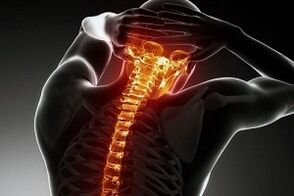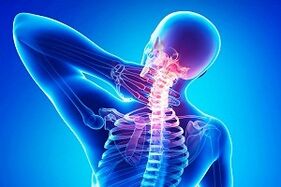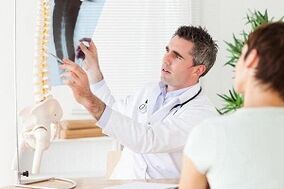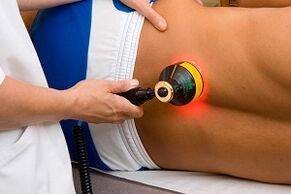
Osteochondrosis is a pathology of the spine that affects millions of people of all ages.
Degenerative and dystrophic changes in the intervertebral discs, the proliferation of osteophytes cause pain syndrome, reduce the mobility of the support column. The symptoms depend on the affected area.
In most cases, adverse events affect not only the pillar of support and the lumbar spine, but also spread to other areas.
In the absence of treatment, the disease progresses, the work of organs and systems is disrupted, the state of health deteriorates significantly, constant pain and complications within the pathology can lead to disability.
It is important to know what osteochondrosis is, the causes of a common disease, and treatment and prevention methods.
The reasons for the development of the disease

Degenerative and dystrophic processes in the intervertebral discs, excessive ossification in the affected area develops in the following cases:
- back injuries;
- high loads in the support position during hard work, professional sports, load carrying.
- congenital defects of the support column.
- Deficiency of vitamins, minerals, deterioration of the quality of the pillow.
- violation of mineral metabolism.
- hormonal disorders, endocrine diseases.
- lack of movement, sedentary work.
- severe obesity;
- reduction of the elasticity of the intervertebral discs in the elderly, with the aging of the body.
- Excessive consumption of strong coffee, carbonated and alcoholic beverages, sour foods, smoked meats, smoking.
- tumor process in the spinal area, causing damage to the elastic structures of the spine.
Types and stages
Osteochondrosis affects all parts of the support column. Degenerative processes are more active in the mobile areas: lumbar and cervical, in the thoracic zone, damage to the vertebrae, bone tissue is less common.
Depending on the affected area, there are several types of osteochondrosis:
- cervical;
- bosom;
- lumbar.
Stages of pathology:
- First stage- the development of cartilage. Lack of nutrients reduces the quality of the tray and reduces the elasticity of the pillow. High loads in the context of thinning of cartilage tissue cause mild to moderate pain in the spine.
- second level.The deformations of the elastic structures are more intense, the pain occurs not only during loads, but also during bending, turning. The defeat of the fibrous ring leads to the pinching of sensitive structures, increased friction of the bone elements.
- third stage.The integrity of the fibrous ring is broken, the disc protrudes beyond the vertebra, the pain syndrome is intense. It is difficult for the patient to do without drugs that reduce discomfort. As part of the destruction of the elastic cushion, the mobility of the support column decreases, protrusions and intervertebral hernias develop.
- fourth stage.The cartilage layer is practically absent, osteophytes appear in the spine. Bone augmentation is an attempt to compensate for the excessive load on the affected vertebrae. The dense elements stabilize the spine, but at the same time reduce the mobility of the problem area of the support column. In the fourth stage of osteochondrosis, the pain subsides, but the patient finds it difficult to perform simple movements. If changes occur in the lumbar region, then paralysis or paralysis of the lower body may occur. Often, in the fourth stage of osteochondrosis, the patient develops a disability.
On a note!Columnar disease occurs with periods of remission (from several months to a year or more) and exacerbations (duration of relapse, pain intensity depends on many factors).
First signs and symptoms

The onset of the disease depends on the stage and the affected area.
The more negative factors, the greater the risk of pain syndrome, damage in other areas.
Blood circulation deteriorates, mineral metabolism is disturbed, protrusions develop, vertebral hernias develop, excessive ossification occurs in the affected area.
Self-medication, the lack of special help, combined with the reluctance to periodically visit a spine specialist, negatively affects the condition of the vertebral structures.
Cervical
The main signs are:
- radical syndrome with severe disc damage.
- pain in the back of the head, neck, crown.
- dizziness, fainting
- headaches;
- discomfort in the muscles of the shoulders, neck.
- numbness of the cervical region, hands, fingers.
- discomfort in the chest area.
- disturbance of the mobility of the cervical spine.
- reduction or loss of shoulder muscle reflexes.
- goose bumps on the hands, fingers.
- With osteochondrosis of the cervical spine, a person suffers from insomnia, depressive states, irritability in the context of excruciating or aching neck and head.
Osteochondrosis of the chest
Typical signs:
- with a long stay in one place, large loads, turns, bends, chest pain appear.
- with a deep breath, he feels discomfort of different force in the middle of the back.
- when you raise your arms, you move your body, the pain increases.
- With the progression of osteochondrosis of the thoracic region, problems appear in the work of the digestive tract.
- in the hands there is an unpleasant feeling of "goose bumps".
- Depending on the degree of damage, doctors distinguish the dorsal - aching painful sensations in the affected spine and the dorsal - acute, excruciating pain of high intensity, which restricts breathing, causes muscle spasm.
- develops intercostal neuralgia.
- pain or acute pain in the shoulder area.
- reproductive disorders occur.
Lumbar area

The main symptoms are:
- discomfort of varying intensity in the lower back.
- muscle weakness, development of paralysis.
- cold and numbness of the lower extremities.
- the pain syndrome is expressed with heavy loads or lifting loads.
- painful lumbar lumbar region occurs: the pain radiates from the lower back to the gluteal area, groin, legs.
- intermittent lameness develops;
- Compression of the nerves adversely affects the work of the pelvic organs: with a severe degree of lumbar osteochondrosis, urinary incontinence, possible involuntary defecation.
- fatigue occurs, it is difficult to stand, long walking causes weakness in the legs.
Diagnostics
To clarify the condition of the spine, you should contact a spine specialist. In the absence of a doctor in this specialty, you should see a neurologist or orthopedic traumatologist.
Diagnostic measures:
- Examination of a patient, examination of complaints.
- Magnetic resonance
- CT.
- X-ray of the spine in several views.
- Vascular Doppler ultrasound.
- Electromyography.
Effective treatments
How is osteochondrosis treated? Chronic pathology requires attention from both the doctor and the patient. Do not expect the negative symptoms to disappear for a week after starting the treatment. Only a comprehensive approach works. The patient must understand that drugs alone can not eliminate the degenerative-dystrophic changes in the discs, to prevent the proliferation of osteophytes.

For the successful treatment and prevention of osteochondrosis, it is important:
- perform an exercise therapy complex.
- attend massage and physiotherapy.
- Healthy food;
- organize a work and sleep area, taking into account the recommendations of a doctor.
- do not lift weights.
- You periodically take vitamins, mineral complexes to maintain the elasticity of the discs, the strength of the bone tissue.
- refuse very intense training.
- Avoid back injuries and bruises.
- monitor your weight.
There are other important rules:
- do not overcool;
- treatment of pathologies that adversely affect the condition of the discs.
- take breaks, warm up while working on the computer.
- move more, do physical education.
- give up excessive consumption of coffee and alcohol, forget about smoking.
- avoid prolonged static / dynamic loads.
- sleep on an orthopedic mattress and low pillow.
- less nervous;
- spend at least 7 hours a night sleeping.
- to periodically visit a spine specialist, to monitor the condition of the vertebral structures.
Medicines
Effective groups and names:
- chondroprotective. . . They restore cartilage tissue, slow down the process of destroying the disc. Course - 4 months or more.
- ΜΣΑΦ. . . Medications relieve pain, eliminate swelling and inflammation. Topical treatments give good results: ointments, gels, plasters.
- B-complex vitamins. . . Medications restore nerve regulation, improve neuronal nutrition, and reduce the severity of pain syndrome. Injections (in the first days, during an exacerbation) and tablets (for a long course of treatment and prevention) are effective.
- muscle relaxants. . . The media treat muscle spasms, which are the main cause of nerve endings.
- compositions that normalize blood circulation.Most often, drugs of this group are prescribed for osteochondrosis of the cervix, against which the brain suffers.
- blockages of the spine, injection into the paravertebral zone. This type of exposure helps with excruciating back pain and the background of stinging nerves in the third or fourth stage of osteochondrosis. Corticosteroids and excipients are added to analgesics to increase the effect.
- GCS group drugs.Steroids are essential for severe pain. Injections are often prescribed for lumbar osteochondrosis, in the background of which develops painful back pain.
Exercise and gymnastics
Exercises for the cervical, lumbar and thoracic regions are prescribed after the relief of acute pain, the reduction of the inflammatory process. For each zone, doctors have developed an exercise therapy complex with varying degrees of stress.
The first sessions are conducted under the guidance of a physiotherapist. After the study of the complex, the patient continues the training at home. It is important to observe the duration and frequency of the sessions in order to achieve the therapeutic effect. In addition to physical education, vertebrates advise to go to the pool: swimming is an ideal type of positive effect on the spine.
Physiotherapy procedures

Effective methods of influence:
- ozokerite applications;
- laser treatment;
- radon and turpentine baths.
- shock wave therapy.
- electrical processes;
- mud treatment;
- phonophoresis and electrophoresis with drugs.
- magnetotherapy.
The following methods give a good result in the treatment of osteochondrosis:
- acupuncture;
- hydrotherapy;
- reflexology?
- using a needle applicator.
- manual therapy;
- dry and underwater traction of the spine.
- medical applicator.
It is quite difficult to prevent the development of osteochondrosis, but doctors advise to remember the factors that cause dystrophic and degenerative processes in the vertebral structures. The more attention a person gives to a healthy lifestyle, the lower the risk of adverse changes in the intervertebral discs.


















































